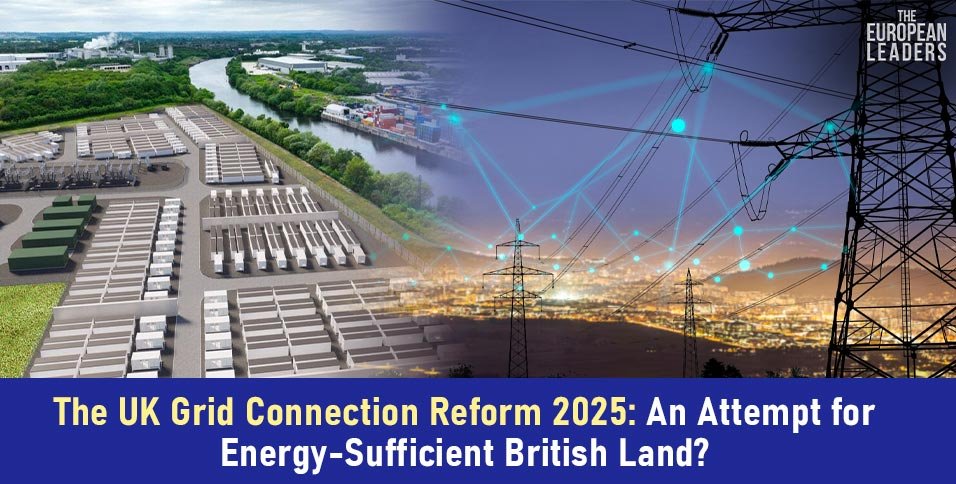The European leaders
17 April 2025
London – In a decisive move that could reshape Britain’s energy landscape, the UK Grid Connection Reform 2025 promises to clear the logjam of delayed projects and fast-track clean energy developments across the country.
As the government and energy regulators press forward with ambitious plans, the reform marks a pivotal shift from sluggish grid connections to a streamlined, investment-friendly system aimed at achieving 95% clean electricity by 2030.
Rewiring the Grid: What’s Changing and Why It Matters
For decades, Britain’s power grid has struggled under the weight of backlogged and often speculative projects, dubbed “zombie projects”, which halted meaningful progress. At present, a staggering 739 GW worth of projects sit idle in the connection queue.
The UK Grid Connection Reform 2025 confronts this head-on by replacing the outdated “first come, first served” approach with a sharper, more strategic “first ready, first connected” system.
In practical terms, this means only those developers with secured land rights, approved planning consent, and solid technical documentation will move forward, cutting out red tape and speculative delays.
The introduction of a Progression Commitment Fee ensures that only serious projects advance, while protecting the grid’s limited capacity for high-value initiatives.
Clean Energy First: Solar, Wind, and Storage in the Spotlight
This reform isn’t just about bureaucracy; it’s about building the backbone of a greener Britain. Solar power capacity alone is being ramped up to 65 GW an enormous leap from previous targets. Energy storage projects and AI-powered demand solutions also receive fast-tracked attention, provided they align with the upcoming Strategic Spatial Energy Plan due in 2026.
The transformation is underpinned by the new National Energy System Operator (NESO), which will hold enhanced powers in grid planning and queue management. With Ofgem’s support, NESO aims to cut consumer costs by an estimated £5 billion, thanks to smarter infrastructure investments that eliminate unnecessary upgrades.
What Does This Means for Small Businesses?
For small businesses, particularly in the renewables, technology, and energy-heavy sectors, the reforms offer both opportunity and challenge. Fast-tracked connections are within reach for prepared players, but the bar for entry is now considerably higher. Clear documentation, financial commitment, and planning readiness are non-negotiable.
Businesses operating in EV charging infrastructure, small-scale solar, or battery storage could gain a competitive edge if they align with national energy priorities. However, competition with large, strategic projects like data centres and AI facilities may squeeze smaller operators unless they demonstrate significant value and readiness.
“These changes will axe ‘zombie’ projects and cut the time it takes to get high growth firms online,” declared Energy Secretary Ed Miliband. “If you want certainty, stability and security when it comes to your investments, choose Britain.”
Timelines Reset: When Will This All Happen?
Implementation kicks off in January 2025, with most applications paused while Ofgem completes its formal approval process.
A one-off connection application window opens in May 2025, after which revised offers will begin rolling out from the second half of the year. Bi-annual application windows will replace the current rolling system, allowing regulators to manage connections more efficiently.
Projects already set for connection before the end of 2026—or those with substantial planning progress—will be protected. Others must meet stringent criteria under Gate 1 and Gate 2 frameworks, each designed to filter out unprepared applicants and prioritise “shovel-ready” developments.
| Sector | Pre-Reform Timeline | Post-Reform Timeline |
| Solar/Wind | 5-7 years | 3-5 years (if strategically aligned) |
| Storage | 4-6 years | 2-4 years (priority for flexibility) |
| Data Centers | 3-5 years | 2-3 years (demand-side priority) |
(Sector-Specific Timeline Changes)
Ofgem CEO Jonathan Brearley summarised the reform’s potential:
“These proposals will supercharge Great Britain’s clean power ambitions… accelerating homegrown renewable power and energy storage while cutting through red tape.”
Risks and Rewards: What Lies Ahead
Despite its promise, the UK Grid Connection Reform 2025 is not without risk. The initial May/June 2025 application windows could overwhelm NESO, while enforcement of post-connection milestones means that any delay in project delivery could see developers lose their place in the queue. It’s a high-stakes environment, particularly for under-resourced small firms.
That said, for those prepared to navigate the new framework, the rewards are substantial. Britain could unlock up to £40 billion annually in private clean energy investment, driving down bills and boosting economic resilience.
Kayte O’Neill, NESO COO, highlighted the collaborative effort:
“Today’s milestone reflects the close collaboration across the energy industry. NESO will prioritise agreements for projects that are critical and shovel ready—giving developers the certainty they need.”
The Bottom Line: Britain’s Energy Future, Recharged
The UK Grid Connection Reform 2025 isn’t just a policy shift—it’s a bold attempt to rewire the nation’s energy future. By removing dead weight and rewarding serious developers, the reform aligns Britain’s infrastructure with its climate ambitions and economic goals.
For businesses and consumers alike, the prospect of cleaner energy, lower costs, and faster connections may finally be within reach.
In a time when energy security, economic growth, and climate action must go hand in hand, the UK is sending a clear signal to global investors and innovators: Britain is open for clean energy business.
For more updates on sustainable infrastructure and policy reform in Britain and across Europe, stay tuned to The European Leaders.








